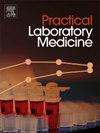应用微滴数字PCR检测阴道加德纳菌的定量诊断方法
IF 1.3
Q3 MEDICAL LABORATORY TECHNOLOGY
引用次数: 0
摘要
核酸扩增试验(NAAT)仍然是最可靠的病原体鉴定方法之一。鉴于传统染色和显微镜检查的高假阴性率,细菌培养方法的耗时和低灵敏度,以及传统NAAT无法实现绝对定量。方法为了实现对阴道加德纳菌的快速定量检测,我们选择23S rRNA基因作为鉴定靶点,建立了一种液滴数字PCR检测方法。结果整个检测过程可在92 min内完成,效率高。灵敏度达4.4 pg/μL, 8种阴性对照病原菌均未检出阳性液滴,具有较高的特异性。此外,阴道加德纳菌的ddPCR检测具有良好的重复性,计算的变异系数为1%。结论ddPCR检测技术对阴道加德纳菌具有绝对定量、高灵敏度、高特异性、高重复性等特点,是一种良好的检测平台。这一进展可为临床诊断和治疗提供更科学的依据。本文章由计算机程序翻译,如有差异,请以英文原文为准。
Quantitative diagnostic method to detect Gardnerella vaginalis by droplet digital PCR
Background
Nucleic Acid Amplification Tests (NAAT) remain one of the most reliable methods for pathogen identification. Given the high false-negative rates associated with traditional staining and microscopic examination, the time-consuming nature and low sensitivity of bacterial culture methods, as well as the inability of conventional NAAT to achieve absolute quantification.
Methods
To achieve rapid and quantitative detection of Gardnerella vaginalis, we selected the 23S rRNA gene as the target for identification and developed a droplet digital PCR detection method.
Results
The entire detection process can be completed within 92 min, demonstrating high efficiency. The sensitivity reached 4.4 pg/μL, and no positive droplets were detected in experiments involving eight negative control pathogens, confirming high specificity. Additionally, the ddPCR assay for Gardnerella vaginalis exhibited excellent repeatability, with a calculated coefficient of variation of 1 %.
Conclusion
The ddPCR detection technology demonstrates characteristics such as absolute quantification, high sensitivity, high specificity, and high reproducibility for Gardnerella vaginalis, showing promise as an excellent testing platform. This advancement could provide a more scientific basis for clinical diagnosis and treatment.
求助全文
通过发布文献求助,成功后即可免费获取论文全文。
去求助
来源期刊

Practical Laboratory Medicine
Health Professions-Radiological and Ultrasound Technology
CiteScore
3.50
自引率
0.00%
发文量
40
审稿时长
7 weeks
期刊介绍:
Practical Laboratory Medicine is a high-quality, peer-reviewed, international open-access journal publishing original research, new methods and critical evaluations, case reports and short papers in the fields of clinical chemistry and laboratory medicine. The objective of the journal is to provide practical information of immediate relevance to workers in clinical laboratories. The primary scope of the journal covers clinical chemistry, hematology, molecular biology and genetics relevant to laboratory medicine, microbiology, immunology, therapeutic drug monitoring and toxicology, laboratory management and informatics. We welcome papers which describe critical evaluations of biomarkers and their role in the diagnosis and treatment of clinically significant disease, validation of commercial and in-house IVD methods, method comparisons, interference reports, the development of new reagents and reference materials, reference range studies and regulatory compliance reports. Manuscripts describing the development of new methods applicable to laboratory medicine (including point-of-care testing) are particularly encouraged, even if preliminary or small scale.
 求助内容:
求助内容: 应助结果提醒方式:
应助结果提醒方式:


